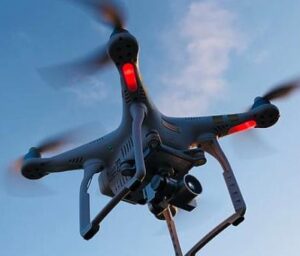EMI shielding for drones and UAVs
Ballston Spa, NY – Russian electronic warfare has destroyed or disabled 90% of Ukraine’s drones, according to Forbes magazine. Some of these unmanned aerial vehicles (UAVs) were fixed-wing aircraft, but many were small quadcopters and octocopters. Multi-rotor drones are the most popular type of UAV today, and they have many civilian applications, such as power-line and pipe inspections, that range far beyond the battlefield.
Whether UAVs are designed for military or civilian use, and whether electromagnetic interference (EMI) is intentional or incidental, drones need protection from EMI to ensure their safe, reliable operation. For UAV designers and manufacturers, meeting this need is an important part of capturing more of a global market that will reach $70.91 billion by 2030, according to Allied Market Research.
The causes of EMI are numerous and can range from electronic jamming and sunspots to electrical motors and wireless communications. EMI is conducted when it travels along a direct route, such as power cables, from a source to a receiver. EMI is radiated when it does not require physical contact and instead travels through the air, such as from electronic jamming devices or overhead power lines.
With drones and UAVs, electromagnetic interference disrupts or distorts signals from ground-based communications. This includes the global positioning system (GPS) signals upon which the drone’s internal compass depends. Conducted EMI onboard the aircraft itself can also disrupt the UAV’s radio receiver or interfere with the flight computer or pulse-width modulated amplifier chip.
EMI shielding for drones and UAVs protects sensitive circuits against electromagnetic interference. Typically, these circuits are part of printed circuit boards (PCBs) that are housed within box-like enclosures. At the board level, specialized EMI adhesives are sometimes used. At the enclosure level, specialized EMI paints or coatings can be applied to surfaces to impart or improve shielding levels.
Some enclosures are made of lightweight, electrically-conductive metals; however, most UAV structures are made of plastics or carbon fiber composites instead. Regardless of the material, enclosures have tiny gaps between mating surfaces. Unless these gaps are filled, the circuits inside the enclosure may radiate or receive signals that cause interference. These gaps can also expose circuits to outdoor environments.
Electrically-conductive silicones are fabricated into compressible, gap-filling gaskets that provide EMI shielding and environmental sealing. Silicone elastomers resist water, moisture, and sunlight while providing both high-temperature and low-temperature resistance. When they are filled with metal, metal-coated, or bimetallic particles, these specialized elastomers also provide electrical conductivity.
Specialty Silicone Products of Ballston Spa, New York (USA) makes conductive silicones for EMI gaskets that are used with drones and UAVs. These specialized elastomers are available with nickel-aluminum, nickel-graphite, silver-aluminum, silver-copper, silver-glass, and silver-nickel fills with proven levels of EMI shielding. Many of these elastomers meet lettered requirements in the MIL-DTL-83528 specification, and some have a qualified product listing (QPL) from the U.S. Department of Defense.

